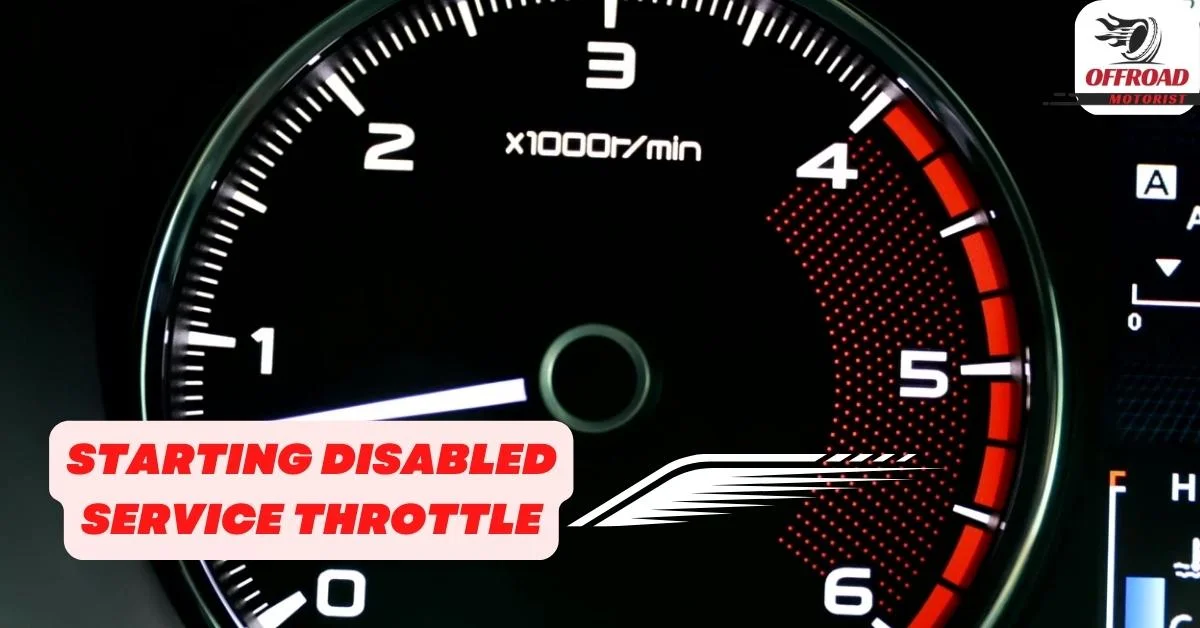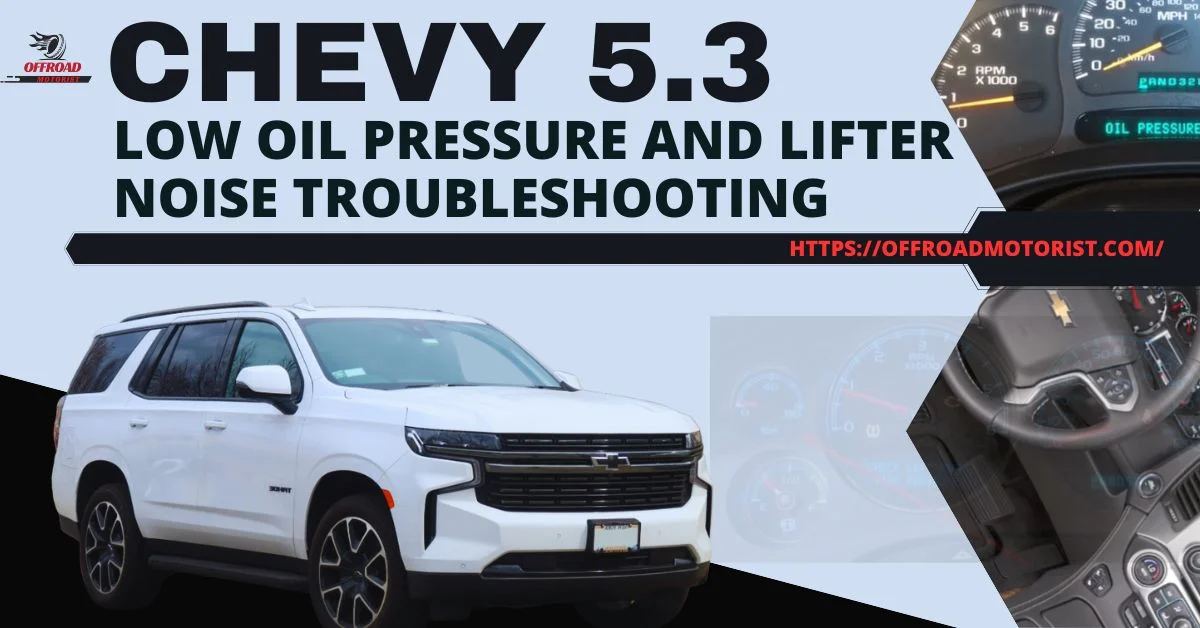Oil Pressure Low Stop Engine Chevy Silverado [Causes and Solutions]
Chevy Silverado is a reliable and robust truck that can handle tough jobs. However, if you notice the oil pressure gauge indicating low pressure or the warning message “Oil Pressure Low Stop Engine” appears on your dashboard. In that case, it is crucial to address this immediately.
Causes of low oil pressure in Chevy Silverado
Low oil pressure in Chevy Silverado can be caused by factors such as oil pump failure, low oil level or dirty oil, clogged oil filter, worn engine bearings, a faulty oil pressure sensor, or other potential causes.
Oil pump failure:
The oil pump is responsible for circulating oil through the engine. The engine won’t receive enough oil if the oil pump fails, resulting in low oil pressure. Wear and tear, clogs, or defects in the pump itself can cause oil pump failure.
Low oil level or dirty oil:
Low or dirty oil levels can also cause low oil pressure in Chevy Silverado. When there isn’t enough oil, the engine won’t receive the lubrication it needs to function properly, which can lead to engine damage over time. Dirty oil can also clog up the engine and passages, reducing oil flow and causing low pressure.
Clogged oil filter:
The oil filter removes contaminants from the oil as it circulates through the engine. If the oil filter becomes clogged, oil flow to the engine can be restricted, resulting in low oil pressure. Over time, a clogged oil filter can also cause engine damage.
Worn engine bearings:
Engine bearings are responsible for supporting the crankshaft and connecting rods. Over time, these bearings can wear out, reducing oil pressure and causing engine damage. Lack of lubrication can also cause engine bearings to wear out prematurely.
Faulty oil pressure sensor:
The oil pressure sensor monitors oil pressure and sends a signal to the dashboard warning light or gauge. If the sensor fails or malfunctions, it can cause inaccurate readings, leading to a false low oil pressure warning.
Other potential causes:
Other potential causes of low oil pressure in Chevy Silverado include a faulty oil pressure gauge, clogged oil galleries, or engine damage due to wear and tear or neglect.
It’s important to address low oil pressure promptly to prevent engine damage and costly repairs.
Symptoms of low oil pressure in Chevy Silverado
Symptoms of low oil pressure in Chevy Silverado include a warning message on the dashboard, low oil pressure gauge reading, engine noise, and poor engine performance.
Warning message on the dashboard:
A warning message on the dashboard is the first and most obvious symptom of low oil pressure in a Chevy Silverado. This warning message will usually be in the form of an oil can symbol or a message that says “low oil pressure stop engine.”
Low oil pressure gauge reading:
Another symptom of low oil pressure is a low oil pressure gauge reading on the dashboard. The oil pressure gauge measures the amount of pressure in the engine’s oil system, and if it shows a reading below the normal range, it could indicate a problem with the engine’s oil system.
Engine noise:
Low oil pressure can cause the engine to make noise. The engine may start knocking, tapping, or rattling sounds due to the lack of oil pressure. This noise is caused by the engine’s metal parts grinding against each other due to a lack of lubrication.
Poor engine performance:
Low oil pressure can also cause poor engine performance. The engine may feel sluggish and unresponsive and accelerate slower than it should. In extreme cases, the engine may stall or fail to start altogether.
Suppose you notice any of these symptoms in your Chevy Silverado. In that case, having your vehicle inspected by a qualified mechanic as soon as possible is essential to prevent further engine damage.
Steps to fix low oil pressure in Chevy Silverado
Low oil pressure in a Chevy Silverado can be a serious issue, leading to engine damage or failure. Here are the steps to fix low oil pressure in a Chevy Silverado:
Step 1: Check oil level and quality
The first step to fixing low oil pressure is to check the oil level and quality. Check the oil level on the dipstick and ensure it’s at the recommended level. Also, check the oil quality to ensure it’s clean and contaminant-free.
If the oil level is low, add oil to bring it to the recommended level. If the oil quality is poor, change the oil. Here are the steps to change the oil in a Chevy Silverado:
- Gather the necessary tools and supplies: Oil filter wrench, drain pan, funnel, new oil, and a clean rag.
- Warm up the engine: Let it run for a few minutes to warm up the oil. This will make it easier to drain the oil.
- Locate the oil drain plug: The oil drain plug is usually on the bottom of the oil pan. Place the drain pan under the plug.
- Remove the oil drain plug: Use a wrench to loosen it and then remove it by hand. Allow the oil to drain completely into the drain pan.
- Replace the drain plug: Clean the drain plug with a rag and then reinstall it. Ensure the drain plug is tight enough.
- Add new oil: Remove the oil filler cap and insert the funnel. Pour in the new oil slowly, checking the oil level with the dipstick as you go. Be sure to use the correct type and amount of oil the manufacturer recommends.
- Start the engine: After adding the new oil, start the engine and let it run for a few minutes to circulate the oil.
- Check the oil level: Turn off the engine and wait a few minutes for the oil to settle. Check the oil level with the dipstick and add more oil if necessary.
That’s it! You’ve successfully changed the oil in your Chevy Silverado.
Step 2: Replace clogged oil filter
Another possible cause of low oil pressure is a clogged oil filter. The oil filter traps contaminants and debris in the oil to prevent them from damaging the engine.
Over time, the filter can become clogged, reducing the oil flow and pressure. If the oil filter is clogged, replace it with a new one. Here are the steps to replace a clogged oil filter in a Chevy Silverado:
- Gather the necessary tools and supplies: New oil filter, oil filter wrench, drain pan, funnel, and a clean rag.
- Locate the oil filter: The oil filter is typically located near the engine block and is easily identifiable as a cylindrical metal canister.
- Prepare the vehicle: Turn off the engine and let it cool down. Elevate the vehicle using jack stands or ramps.
- Drain the oil: Place a drain pan under the oil filter to catch any spilled oil. Use the oil filter wrench to loosen the oil filter and unscrew it by hand. Allow the oil to drain completely into the drain pan.
- Remove the old filter: Clean the filter housing with a rag. Inspect the old filter and dispose of it properly.
- Install the new filter: Lubricate the gasket on the new filter with a small amount of fresh oil. Screw the new filter onto the filter housing by hand. Tighten the filter by turning it one-half to three-quarters of a turn after contacting the filter housing.
- Add new oil: Remove the oil filler cap and insert the funnel. Pour in the recommended amount and type of new oil slowly, checking the oil level with the dipstick as you go.
- Check for leaks: Start the engine and let it run for a few minutes. Check for leaks around the filter housing and oil drain plug. Turn off the engine and check the oil level with the dipstick again.
- Dispose of the old oil and filter: Pour the old oil into a sealable container and take it to a recycling center or a repair shop that accepts used oil. Similarly, dispose of the old filter.
Using the correct size oil filter and lubricating the gasket before installing the new filter is essential. Remember to properly dispose of the old oil filter in a recycling center or a repair shop that accepts used oil.
Step 3: Replace the oil pump or oil pressure sensor
If the oil level and quality are fine, the next step is to check the oil pump and oil pressure sensor. The oil pump is responsible for circulating the oil through the engine, while the oil pressure sensor measures the oil pressure and sends signals to the dashboard gauge.
If the oil pump is faulty or worn out, it won’t be able to circulate oil properly, leading to low oil pressure. Similarly, if the oil pressure sensor is faulty or damaged, it can send false signals to the dashboard gauge, indicating low oil pressure even when the pressure is normal.
In both cases, the solution is to replace the faulty component. You can replace the oil pump and oil pressure sensor in your Chevy Silverado by following these steps.
Replacing the Oil Pump:
- Gather the necessary tools and supplies: New oil pump, oil pan gasket, oil pump pickup tube O-ring, oil pressure gauge, socket wrench set, torque wrench, oil filter wrench, drain pan, and a clean rag.
- Drain the oil: Place the drain pan under the oil pan and remove the drain plug to drain the oil.
- Remove the oil pan: Use a socket wrench to remove the bolts holding the oil pan. Be careful not to damage the oil pan gasket.
- Remove the oil pump: Locate it inside the engine and remove the bolts holding it. Carefully remove the old oil pump, ensuring not to damage any surrounding components.
- Install the new oil pump: Install the new one, ensuring it is properly aligned with the engine. Torque the bolts to the manufacturer’s specifications.
- Replace the oil pan: Install a new gasket and reattach the oil pan with the bolts. Torque the bolts to the manufacturer’s specifications.
- Refill the oil: Add new oil to the engine through the oil filler cap. Check the oil level with the dipstick and add more oil if necessary.
Replacing the Oil Pressure Sensor:
- Locate the oil pressure sensor: The oil pressure sensor is usually near the oil filter.
- Remove the electrical connector: Disconnect the electrical connector from the oil pressure sensor.
- Remove the oil pressure sensor: Use an oil filter wrench to remove the oil pressure sensor.
- Install the new oil pressure sensor: Apply Teflon tape to the threads of the new oil pressure sensor and screw it into place. Tighten the sensor to the manufacturer’s specifications.
- Reconnect the electrical connector: Connect the electrical connector to the oil pressure sensor.
- Check the oil pressure: Start the engine and check the gauge to ensure it’s working properly.
Safety Issues:
- Always disconnect the battery cables to prevent electrical shock or damage to the engine control module.
- Allow the engine to cool down before working on the oil pump or oil pressure sensor to prevent burns from hot surfaces or oil.
- Wear gloves and safety goggles to protect your hands and eyes from oil and other chemicals.
- Use jack stands or a hoist to support the vehicle while working underneath it to prevent accidents.
- Be sure to dispose of the old oil and oil pump properly.
It’s essential to use the correct tools and torque the bolts to the manufacturer’s specifications to ensure the repair is done correctly.
Step 4: Repair or replace worn engine bearings
Worn engine bearings can also cause low oil pressure in a Chevy Silverado. The engine bearings help support the crankshaft and other moving parts.
If the bearings are worn out or damaged, they won’t be able to provide proper support, leading to excessive oil clearance and low oil pressure. In this case, the solution is to repair or replace the worn engine bearings.
Repairing or replacing worn engine bearings in a Chevy Silverado requires expertise and specialized tools. If you’re unfamiliar with engine repair or need the necessary tools, it’s best to seek the help of a professional mechanic.
A professional mechanic will have the experience and expertise to diagnose the issue with your engine and determine whether the engine bearings need to be repaired or replaced. They’ll also have the specialized tools and equipment to perform the repair correctly.
While it may be tempting to attempt the repair yourself to save money, a mistake during the repair process can cause severe damage to the engine or even result in complete engine failure.
Note: It’s best to trust a professional mechanic to ensure the repair is done correctly and safely.
Step 5: Other possible solutions
If the above steps don’t solve the problem, other underlying issues might be causing low oil pressure. These could include a faulty oil pressure relief valve, a blocked oil passage, or a worn-out oil pump drive gear.
In such cases, it’s best to consult a professional mechanic to diagnose and fix the issue.
Tips for maintaining oil pressure in Chevy Silverado
Maintaining oil pressure in Chevy Silverado requires regular oil changes, using the correct type of oil, checking the oil level frequently, and regular engine maintenance.
01. Regular oil changes:
Regular oil changes are crucial for maintaining oil pressure in Chevy Silverado. Over time, oil can become contaminated with dirt and debris, reducing its effectiveness in lubricating the engine.
Changing the oil and oil filter at the recommended intervals outlined in the owner’s manual is essential to keep the engine running smoothly.
02. Using the correct type of oil:
Using the correct type of oil is also essential for maintaining oil pressure in Chevy Silverado. The owner’s manual will specify the correct viscosity and oil type.
Using the wrong type of oil can reduce its effectiveness in lubricating the engine, resulting in low oil pressure.
03. Checking oil level frequently:
It’s essential to check the oil level frequently to ensure it is at the proper level. Low oil levels can cause low oil pressure and, if left unchecked, can cause severe engine damage.
Check the oil level at least once a month and always before a long trip.
04. Regular engine maintenance:
Regular engine maintenance can help prevent low oil pressure in Chevy Silverado. This includes replacing worn parts, such as engine bearings or oil pumps, as soon as they show signs of wear and keeping the engine clean and free of debris.
It’s also essential to follow the manufacturer’s recommended maintenance schedule. By following these tips, you can keep your engine running smoothly and prevent low oil pressure from occurring.
FAQs on Chevy Silverado Low Oil Pressure Problem
We’ve compiled some of the frequently asked questions in this section. Read on to learn more about diagnosing and fixing low oil pressure issues and keeping your Silverado running smoothly.
What is the oil pressure sensor for a Chevy Silverado?
The oil pressure sensor in a Chevy Silverado monitors the oil pressure and sends a signal to the vehicle’s computer or dashboard gauge. If the oil pressure drops below a certain level, the sensor will trigger a warning light or alarm the driver. This helps prevent engine damage or failure by allowing the driver to address low oil pressure issues promptly.
Why is my Chevy displaying oil pressure low stop engine, but the oil is full?
Possible causes of low oil pressure, even when the oil level is full, include a failing oil pump, clogged oil passages, or worn engine bearings. A faulty oil pressure sensor or gauge can also give false low oil pressure readings. Additionally, there may be a leak in the oil system or an issue with the oil filter. Please consult a professional mechanic as soon as possible.
How much does it cost to fix low oil pressure in a Chevy Silverado?
The cost to fix low oil pressure in a Chevy Silverado will vary depending on the underlying issue and the cost of replacement parts. Labor costs may vary depending on the location and experience of the mechanic.
What happens if you drive with low oil pressure in a Chevy Silverado?
Driving a Chevy Silverado with low oil pressure can cause engine damage or failure. The engine may overheat due to insufficient lubrication, causing internal components to warp or seize. Other potential consequences of low oil pressure include engine noise, reduced fuel efficiency, and increased emissions.
Is it safe to drive with low oil pressure in a Chevy Silverado?
No, driving a Chevy Silverado with low oil pressure is unsafe. Low oil pressure can cause engine damage or failure, leading to expensive repairs or even the need for an engine replacement.
How often should I check the oil pressure in my Chevy Silverado?
It is recommended to check your Chevy Silverado’s oil pressure at least once a year or more frequently if you notice any signs of low oil pressure. It is also essential to check the oil level regularly and to change the oil and oil filter according to the manufacturer’s recommended schedule.
Final Thoughts on Low Oil Pressure in Chevy Silverado
Low oil pressure is a warning sign that should never be ignored in a Chevy Silverado. Ignoring low oil pressure can lead to serious engine damage and even complete engine failure.
Therefore, it is essential to maintain proper oil pressure in a Chevy Silverado by performing regular maintenance and addressing any issues promptly.
Remember, regular maintenance is crucial for the longevity of your Chevy Silverado, and paying attention to low oil pressure can result in expensive repairs.

![Chevy Transfer Case Interchange Chart [Everything you need to Know] chevy transfer case interchange chart](https://offroadmotorist.com/wp-content/uploads/2023/03/chevy-transfer-case-interchange-chart-150x150.jpg)
![Chevy 2500HD Transfer Case Problems [Causes, Symptoms, and How to Fix] chevy 2500hd transfer case problems](https://offroadmotorist.com/wp-content/uploads/2023/03/chevy-2500hd-transfer-case-problems-150x150.jpg)









